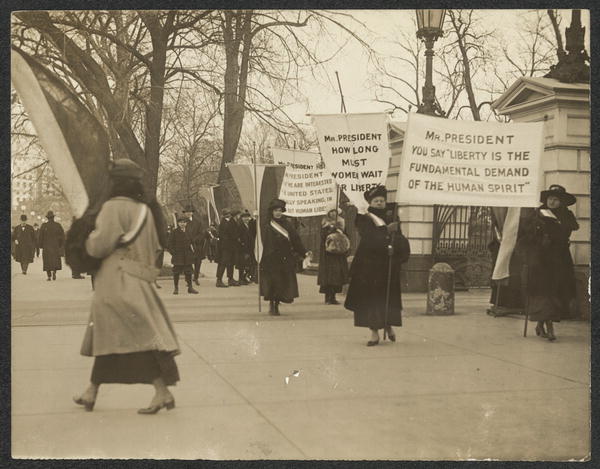Why do we know more about Alice Paul’s contemporary, Ghandi, than about Alice Paul? The Alice Paul who put women’s suffrage on the front page of newspapers, making it impossible for President Wilson and federal legislators to ignore. The Alice Paul who “created her own highly influential version of nonviolent activism, one that exploited new forms of mass persuasion to forge a new status for women.” (Adams and Keene, xviii)
Suppression of role models for women and BIPOC folks by the patriarchy messes with our minds. In the 1970s there were few women that I looked to as role models. I’m not saying there weren’t any. There were, of course, women from history that I could look to for inspiration. Yet, their scarcity made them appear special, and thus out of reach. More importantly, they were pink-washed,“model women” that the patriarchy could get behind. (More about pink-washing soon). I can’t speak to BIPOC experiences, although there are more than a few similarities. For the purposes of this blog, I will speak of my own experiences as a white girl and woman.
I was told that I could do anything by my parents, but my culture told me otherwise. However, because of the encouragement of my parents and teachers, I was one of only a few women in my class to get a degree in physics and computer science from Hamline University and in the minority again as a coder for Honeywell in the 1980s.
The effects of patriarchy run deep and are difficult to un-earth, the lack of role models being just one tactic to keep women and non-white men in their place. I can’t say I knew much about the suffrage movement until about 15 years years ago. It seemed to me a rather boring topic, really. That changed when I saw “Iron Jawed Angels” (2004 on HBO) soon after it came out, at of all places, my church. I had never heard of Alice Paul and and how she spearheaded picketing the White House and other non-violent tactics that pushed the right of women to vote to the front of public consciousness.
I didn’t know that Alice Paul and other suffragists went on hunger strikes and were force fed because their demands to be treated as political prisoners went unheeded. I had never heard about the “Night of Terror” when suffragists “were beaten, pulled down by their hair, and handcuffed to beds.” (xiv) Basically, I had no idea how revolutionary their ideas were and how strong and brave these women had to be. I simply had no idea. That’s the crux of patriarchy: keep the stories of brave and powerful women and BIPOC folks hidden (or pink-washed or white-washed) so that we don’t know what we are capable of, because the power of role models is that they show us what is possible!
One of the books I devoured while I was doing research for “Only the Few Brave Souls” detailed Alice Paul’s accomplishments and shed some light on why we don’t know more about her and the National Women’s Party. In the introduction to “Alice Paul and the American Suffrage Campaign,” the authors note, “During the years in which Paul worked for a federal amendment, 1912 to 1920, she was certainly not an unknown advocate. Instead, she was perhaps the one securing the most national attention. To this campaign she brought a superior education in political reform.” (xii) And yet, “[t]he official removal of her story was in fact beginning before the campaign ended,” because “…her story disparaged both Democrats and Republicans and reveled dirty truths about American police and jails as well as the president.” (xv) In fact, “[i]t has been within only the last twenty years that historians have begun to reconsider the established version of the suffrage campaign as sole Anthony’s and NAWSA’s story.” (xv)
After I’m finished being angry for not knowing any of this growing up and, equally infuriating, for my children not being taught this as well, I realize that knowing more about brave woman of all races and ethnicities and un-earthing their stories has transformed me. It is the stories of the women who stood in extreme weather, “day after day at the gates of the White House with banners asking, ‘What will you do Mr. President for one half of the people of this nation?’” (The Suffragist, 7) and the women who suffered in jail that continue to inspire me to get out of my house and into the street to protest equality for all those who are disenfranchised. These brave women and their stories are the inspiration for the bold and radical lyrics of a new dramatic art song cycle, “Only the Few Brave Souls.”
Stories Matter.
Note: White suffragists were often not inclusive with regard to women of color within the movement. While our choice of texts cannot fully repair the damage caused, this cycle includes an excerpt from a kick-ass essay from Mary Church Terrell in an effort to widen the narrative. Check out all the lyrics here
Who do you look to as a role model? How have your role models changed over the years?
References
Alice Paul and the American Suffrage Campaign, by Katherine H. Adams and Michael L. Keene, University of Illinois Press, copyright 2008.
The Suffragist, the weekly organ of the Congressional Union for Woman Suffrage and the National Woman’s Party, Miss Alice Paul, Chairman, Vol. IV, No. 55, 17 January 1917.
More blogs in this series:
They did what? Missing Stories of Powerful Women of the Suffrage Movement
The Art Song Cycle “Only the Few Brave Souls,” was commissioned by Anna DeGraff and Gustavus Adolphus College with generous funding from the Ethel and Edgar Johnson Fund will be premiered on Nov. 20, 2021 at 7:00 pm, Bjorling Recital Hall, Gustavus Adolphus College,800 W College Ave, St Peter,Minnesota 56082

